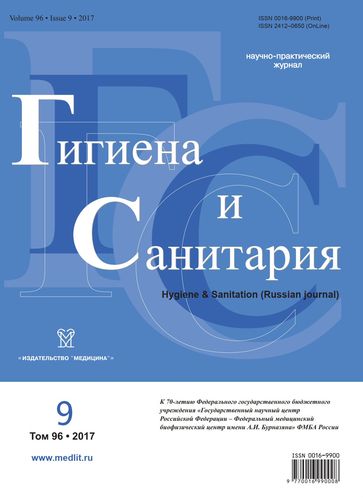Detection of pathway of tritium entry into freshwater organisms in the exploitation of the mining and chemical combine
- Authors: Lashchenova T.N.1, Bondareva L.G.2, Fedorova N.E.2, Rakitsky V.N.2
-
Affiliations:
- A.I. Burnazyan Federal Medical Biophysical Centre
- F.F. Erisman Federal Center of Hygiene
- Issue: Vol 96, No 9 (2017)
- Pages: 844-848
- Section: ENVIRONMENTAL HYGIENE
- Published: 21.10.2020
- URL: https://rjsocmed.com/0016-9900/article/view/640746
- DOI: https://doi.org/10.47470/0016-9900-2017-96-9-844-848
- ID: 640746
Cite item
Full Text
Abstract
The global pollution of the environment and the functioning of the Mining and Chemical Combine (MCC), Rosatom State Corporation are potential sources of tritium in the Yenisei River ecosystem. The distribution of residual tritium in organs and tissues of the freshwater rayfinned fish Carassius gibelio (Prussian carp) as a representative of the Carassius phytophagous genus of Cyprinidae family was studied for the determination of the 3Н accumulation in the aquatic plants-fishes food chain in water bodies contaminated with radionuclides. At the first stage, the work was done on the accumulation of tritium by the biomass of hydrobiont plants. To do this, 3000 g of biomass in terms of wet weight were placed in aquaria with a volume of 100 liters with specific water activity of 100 kBq/l. The work shows mentioned aquatic plants to accumulate actively the introduced tritium, storing up to 70% of the radionuclide. At the same time, the content of organically bound tritium in biomass increased to 21% of total accumulated tritium. Then the plants (hornwort, duckweed) were dried, mixed with dry fish food (1: 1), and the mixture was compressed into pellets, each with activity up to 50 Bq. The pellets were used for forcible feeding of fish, during the experiment, each individual absorbed up to 330 kBq of tritium radionuclide for 550 days. Studies have shown about 75% of the total accumulated amount of tritium in fish specimens to present in muscle tissue. When determining the content of tritium in proteins and lipids in experimental systems, no specific features have been revealed in the use of Ceratophyllum and Lemna as a source of nutrition.
Keywords
About the authors
T. N. Lashchenova
A.I. Burnazyan Federal Medical Biophysical Centre
Author for correspondence.
Email: noemail@neicon.ru
Russian Federation
Lydia G. Bondareva
F.F. Erisman Federal Center of Hygiene
Email: lydiabondareva@gmail.com
MD, PhD, associate professor, senior researcher of the department of analytical methods of the F.F. Erisman Federal Center of Hygiene, Mytischi, 141014, Moscow region, Russian Federation.
e-mail: lydiabondareva@gmail.com
Russian FederationN. E. Fedorova
F.F. Erisman Federal Center of Hygiene
Email: noemail@neicon.ru
Russian Federation
V. N. Rakitsky
F.F. Erisman Federal Center of Hygiene
Email: noemail@neicon.ru
Russian Federation
References
- Environmental Isotope Data: World Survey of Isotope Concentration in Precipitation. Vienna: IAEA; 1979.
- Katrich I.Yu. Tritium monitoring in natural waters of the USSR (Russia): Diss. Obninsk; 2009. (in Russian)
- UNSCEAR Document A/AC.82/R.360: Contamination from Nuclear Explosions. UNSCEAR; 1979.
- The Tritium Systems Test Assembly at the Los Alamos National Laboratory, Los Alamos National Security, Benefits LANL, NNSA & National Security, DOE. Los Alamos; 2002.
- Report and Advice on the Ontario Drinking Water Quality Standard for Tritium. Toronto: Ontario Drinking Water Advisory Council; 2009.
- Park J.W., Lanier T.C. Processing of surimi and surimi seafood. In: Martin R.E., ed. Marine Freshwater Products Handbook. Lancaster: Technomic, 2000.
- Benedict B.C., Bradshaw C. Bioaccumulation of tritiated water in phytoplankton and trophic transfer of organically bound tritium to the blue mussel, Mytilus edulis. J. Environ. Radioact. 2013; 115: 28–33.
- Davis P., Galeriu D. Environmental Radioactivity and Ecotoxicology of Radioactive Substances. Berlin: Springer; 2011.
- Galeriu D. Tritium. Radionuclides in the Environment. West Sussex: John Wiley& Sons Ltd.; 2010.
- Galeriu D., Melintescu A. Tritium in Radionuclides in the Environment. West Sussex: John Wiley& Sons Ltd.; 2010.
- Galeriu D., Heling R., Melintescu A. The dynamics of tritium – including OBT – in the aquatic food chain. Fusion Sci. Technol. 2005; 48: 779–82.
- Kim S.B., Shultz C., Stuart M., McNamara E., Festarini A., Bureau D.P. Organically bound tritium (OBT) formation in rainbow trout (Oncorhynchus mykiss): HTO and OBT-spiked food exposure experiments. Appl. Radiat. Isot. 2013; 72: 114–22.
- Konig L.A. Tritium in the food chain. Radiat. Prot. Dosimetry. 1990; (2): 77–86.
- Bondareva L. Natural Occurrence of Tritium in the Ecosystem of the Yenisei River. Fusion Sci. Technol. 2011; (4): 1304–7.
- Bondareva L., Zeer G., Gerasimov V., Zhizaev A. Technogenic pollution and its migration in the water flow of the Yenisei River. River Systems. 2013; (3-4): 149–56.
- Bolsunovsky A.Ya., Bondareva L.G. Tritium in surface waters of the Yenisei River basin. J. Environ. Radioact. 2003; 66: 285–94.
- Bondareva L.G. Tritium Content of Some Components of the Middle Yenisei Ecosystem. Radiochemistry. 2015; (5): 557–63.
- Zuev I.V., Semenova E.M., Shulepina S.P., Reznik K.A., Trofimova E.A., Shadrin E.N., et al. Feeding Composition of Grayling Thymallus Sp. in the Middle Reach of the Yenisei River. Zhurnal Sibirskogo federal'nogo universiteta. Seriya: Biologiya. 2011; 4(3): 281–92. (in Russian)
Supplementary files









